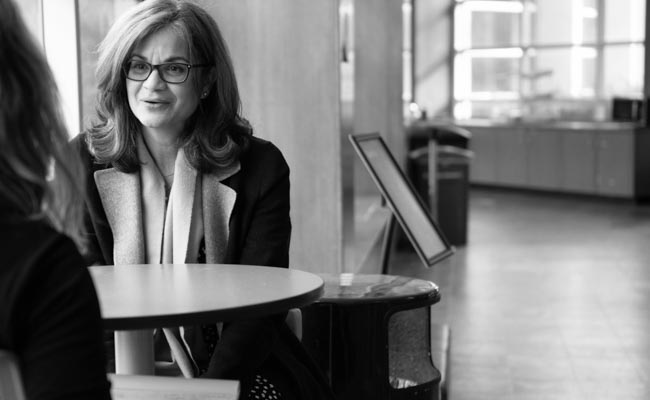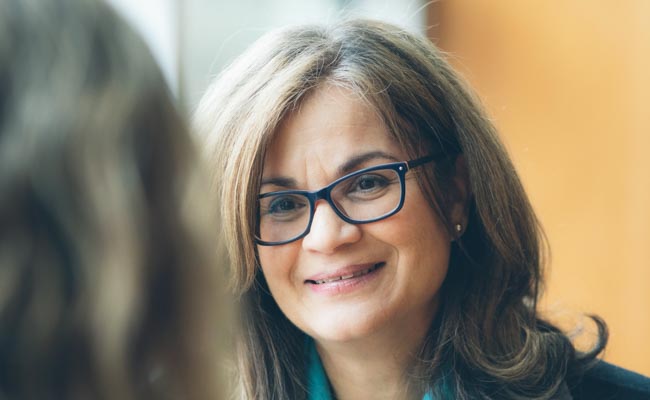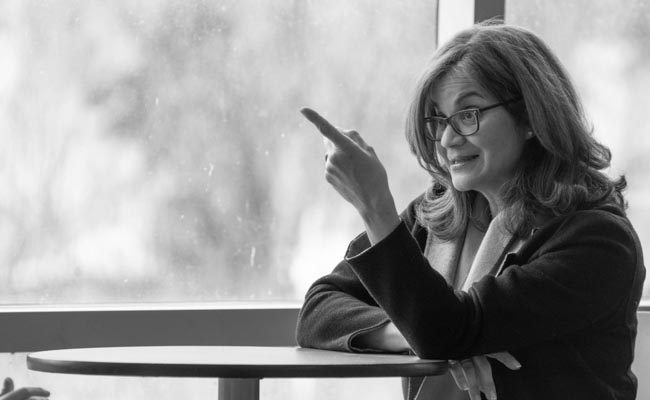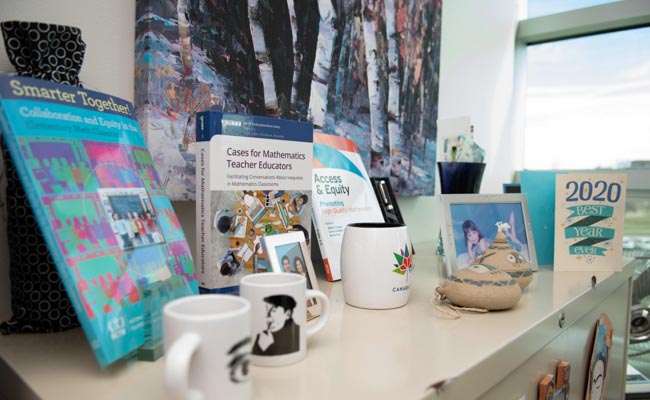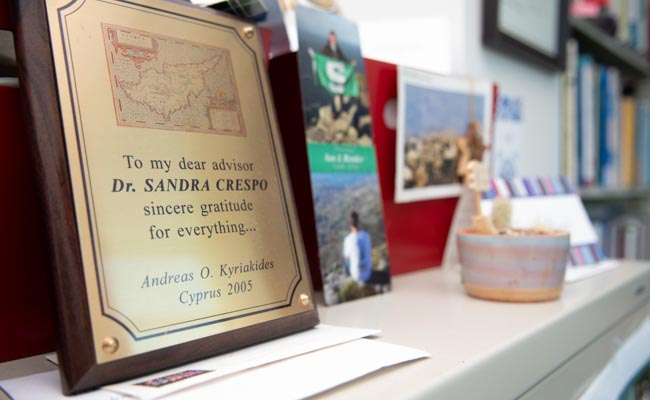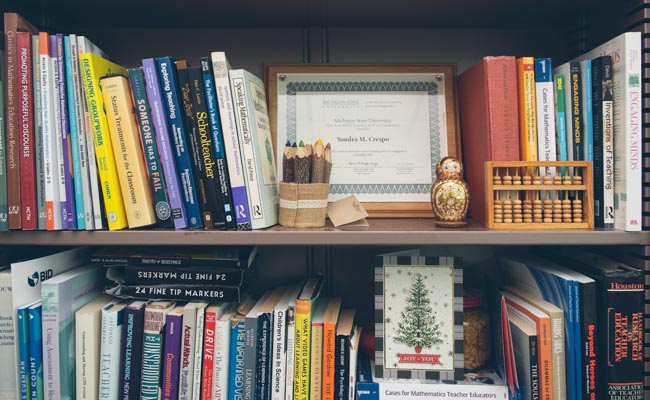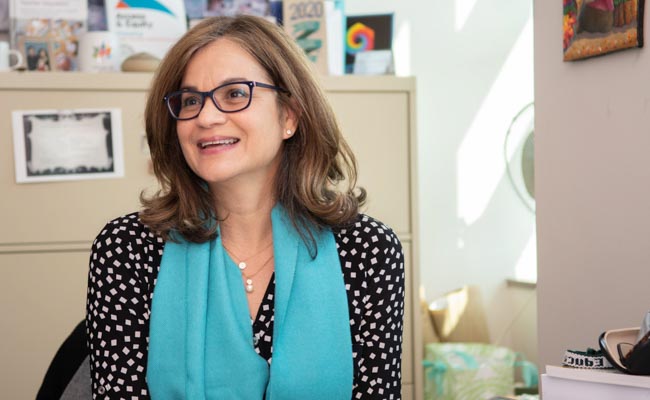
How Sandra Crespo has been changing math, leading change and sharing inspiration throughout her career
By Lauren Knapp
“Why does it need to be this hard? There has to be a better way of teaching this.”
That thought is what has propelled Sandra Crespo, the first Latina to become a full professor in MSU’s Department of Teacher Education, for much of her career.
From an early age, she knew she wanted to be a teacher. She was often asked by teachers to help other students, and enjoyed study groups with peers.
Math, in particular, was something in which she found joy. And yet, while she was flying through algebra, geometry, pre-calculus—“when math starts to get interesting,” in her own words—she noticed her friends were struggling. They were equally capable learners and smart students, but math seemed to be a source of trepidation.
“I was drawn to math because of seeing how my friends were struggling when I wasn’t,” Crespo recalled about growing up in the Dominican Republic. “It wasn’t fair. I thought: Something must be going on here. There cannot be that many people who are running away from the subject. So, the problem is not the students … the problem has to be an issue with the curriculum, or the teaching, or something. There has to be some issue in the way we’re teaching this that I can figure out.”
CREATIVE THINKING
To solve the mystery, Crespo has spent much of her career thinking about “problem-posing” in mathematics, or how math problems are written and constructed.
In most cases, math problems are written by teachers or textbook writers. That, Crespo believes, is part of the problem.
“If all your life, you had only read and had never written, you would only have experiences on one side of what it is to be literate,” she explained. “In math, if you’ve only been given the opportunity to solve problems, you’ll never have the experience of authoring. Knowledge production is so important. It enhances the sense of ownership and agency. It creates an ‘I made this!’ mentality, which gives students a sense of empowerment in mathematics.”
By having students write their own math problems and express creatively through mathematics, Crespo believes it helps children see their ideas have value and purpose.
She took that idea and incorporated it into a research project from 2007-10.
She was co-principal investigator on a more than $1 million grant from the National Science Foundation that explored things kids interacted with and enjoyed outside of school—sports, games and watching TV shows like Cyberchase on PBS, an educational math program. The goal was to help teachers find ways to bring the outside world into the classroom, to build lesson plans around things beyond textbooks (see Read More, below).
What Crespo learned through this project has been integrated into the Teacher Preparation Program and is still in use today. Future Spartan educators learn to get to know their students outside of the classroom in order to bring those experiences into lesson plans.
“The kids’ creativity and joy in learning just exploded. In those early learning years, that’s crucial,” Crespo added. “If kids get the idea that you have to conform to particular ways, learn in particular formats, they will give it up. It’s not a fight we should be fighting.”
FINDING MSU
Crespo started her career as a high school math teacher and college instructor and, later, as a research assistant on a project creating textbooks and facilitating professional development for teachers, and collecting data to see if the materials worked.
“It was a dream project. It gave me a taste of seeing what professors do, what it would be like to work as a researcher. It showed me how I could combine my love of teaching and researching.”
As she earned a master’s in mathematics education and a Ph.D. in curriculum studies from the University of British Columbia, she worked more with undergraduates and preservice teachers. New questions began forming.
“How do people learn to teach? How did I learn to teach? How am I learning to teach?” she said. “Every time you get a new set of students, you’re learning and relearning and gaining new skills and revising what you thought. It’s a constant process of learning, and it’s fascinating.”
Equally fascinating was the work she was reading by former and current Spartan scholars who were doing important work in teacher education. This included Magdalene Lampert, Deborah Loewenberg Ball, Helen Featherstone, Suzanne Wilson, Sharon Feiman-Nemser, Dan Chazan, Jack Smith, Ralph Putnam, Charles “Andy” Anderson and Robert E. Floden, current dean of the college.
At the time, Ball (now at the University of Michigan) was conducting research on multimedia materials that Crespo found interesting. Crespo wrote to Ball, asking for insight on the project. Ball responded, and invited Crespo to a summer institute MSU was hosting.
Without that early collaborative experience, Crespo is “not sure she would have applied” to join the MSU faculty, which she did in 1998.
“MSU was doing amazing work,” Crespo recalled. “It was not just a site for producing teachers and textbooks … it was about how can we make teacher education better.”
A HUB OF LEARNING
In the following years at MSU, Crespo served as principal investigator (PI) or co-PI on four distinct grants working to improve mathematics teacher preparation, or to develop professional development to help teachers grow in their career.
In 2006, Crespo and colleagues from the Department of Teacher Education were exploring how to teach future Spartan educators to create learning environments that worked for all students, and not just a few.
They researched how to make classrooms more equitable and inclusive, and how to help preservice teachers learn and use Complex Instruction—a teaching method that focuses on paying attention to students’ unequal participation and interrupting patterns of exclusion and competitive learning in the math classroom (see Read More, below).
“As an instructional team, we made a commitment to learn this new teaching method and to reconstruct our Teacher Preparation Program to have mentor teachers, teacher candidates and course instructors try this in our elementary program,” Crespo said.
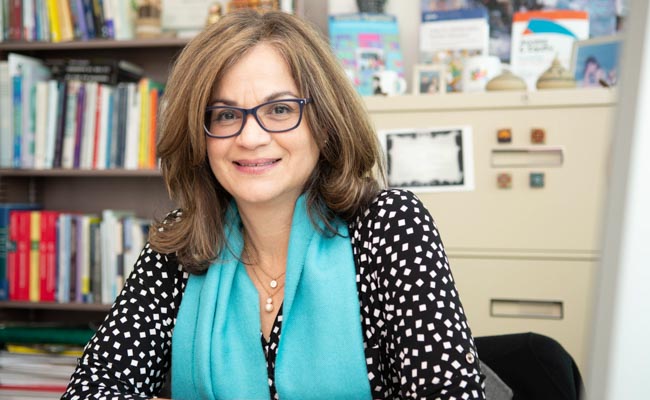
The same colleagues who made this commitment—Helen Featherstone, Crespo, Lisa Jilk, Joy Oslund, Amy Parks and Marcy Wood—then wrote “Smarter Together! Collaboration and Equity in the Elementary Math Classroom” (National Council of Teachers of Mathematics, 2011) about using Complex Instruction in the classroom.
“That book really exemplifies the ways in which and why MSU has been and continues to be the hub of learning about teacher education,” Crespo said. “MSU was a leader at the time I joined the faculty, and it still is leading the way for future teacher educators.”
TRAILBLAZER
Crespo believes some of her success is owed to her parents opening educational opportunities that they themselves did not have. Although it was an economic burden, they insisted that Crespo and her brother learn English as an additional language in an afterschool English learning institute through their K-12 schooling while still living in the Dominican Republic. While the siblings are fluent in Spanish and English, their parents only speak Spanish.
“They did that for us to open opportunities,” she said. “We never know where it will lead, but I always say ‘opportunity meets preparation.’”
Opportunity has been presented in the ways Crespo has contributed to MSU’s legacy of leadership: She was coordinator of the Curriculum, Instruction and Teacher Education (CITE) Ph.D. program from 2014-2018 and in 2019 was named associate chair for graduate education within the Department of Teacher Education.
In 2015, she was the first Latina to earn full professorship within the department—and two years later, was presented with the William J. Beal Outstanding MSU Faculty Award, recognizing an exemplary and sustained record of scholarly excellence in research, instruction and outreach to Michigan State University.
These distinctions, and more, are integral to Crespo’s motivation.
“We need more women in STEM (science, technology, engineering and mathematics). We need more women of color to not be discouraged from being in STEM spaces and pursuing careers in science. I sometimes ask: ‘Why aren’t there more of me here? Or anywhere?’ Representation is hugely important. There has to be more ways in which people can be successful. That’s what drives me to open up those spaces for the next generation of students and teachers of color.”
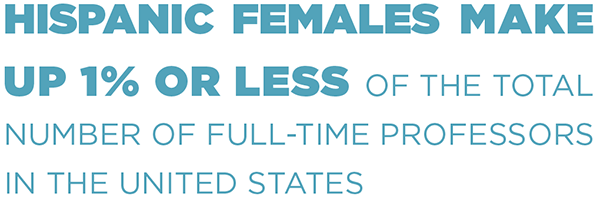
Dorinda Carter Andrews, chairperson of the Department of Teacher Education, finds motivation and inspiration in Crespo’s legacy.
“She’s been a trailblazer as a woman of color, as a scholar of color,” she said. “Through her leadership, she has shown the possibilities of different avenues you can take in the academy. It gives junior women scholars of color a sense of who they can become, who they can be, without having to give up aspects of their identity.”
THE NEXT GENERATION
Crespo was one of the first people Jasmin Patron-Vargas encountered when considering MSU.
Now a doctoral student in the CITE program, Patron-Vargas was exploring what program would fit for her when she met Crespo during an on-campus visit. She found many things to love at MSU—it was close to her hometown of Chicago, and the college offered financial support, plus it housed many nationally top-ranked programs and faculty members.
But, for fellow Latina Patron-Vargas, there was also the draw of Crespo herself.
“Seeing faces in leadership positions that represent my own Latina ethnic background is comforting and provides empowerment,” she said.
Patron-Vargas also is a member of Rueda Latin@, a College of Education organization providing mentorship opportunities to Latinx graduate students as they learn to navigate higher education (see below). Crespo serves as an advisor alongside Patricia Marin, assistant professor of Higher, Adult and Lifelong Education.
“She’s busy, I’m busy, we’re all busy. But she always makes sure to stop and ask me how I’m doing,” Patron-Vargas said. “It shows how much she cares. It helps humanize my experience.”
THERE’S MORE TO DO
Through her history of work, Crespo has built a legacy of supporting equity and inclusion. It’s why she still is continuing her work on promoting classrooms as collaborative learning spaces, instead of one where students may find competition, as she saw with her peers in the Dominican Republic when she was younger. Her friends were frustrated they weren’t succeeding in math, which ultimately “shortchanged their opportunities to learn,” a result many still experience.
“She’s a part of this group of women of color who are saying: We’re doing good work in the classroom, but it’s time for us to step into more prominent leadership roles. Our voices matter.”
Dorinda Carter Andrews
What started as a drive to help people like her friends has continued throughout Crespo’s career to help all students, like Patron-Vargas, experience academic success in a supportive learning community.
It’s evident in her work: An example of co-authored research in 2018 features a process to help teachers notice students’ mathematical strengths, rather than their deficits.¹ Another example, from 2019, provides teachers with eight teaching strategies to help increase participation in math for
all students.²
And yet, there is still room to grow. For as much as Crespo has created and changed and, yes, been a trailblazer, there are gaps in learning, in success and in humanizing education.
“We’re constantly trying to be better, but there is still a lot we need to do,” Crespo said. “At MSU, our Teacher Preparation Program and other programs continue to innovate and improve on what we are doing. There are a lot of things we know how to do well, but that doesn’t mean it’s the end of it. We still need to do better for future educators and learners.”
KEY CAREER MOMENTS
- Associate Editor, Journal for Research in Mathematics Education (2019-24)
- Program Chair and Co-Chair of the American Educational Research Association’s (AERA) special interest group, Research in Mathematics Education (2018-20)
- Co-editor, “Access and Equity: Promoting High-Quality Mathematics in Grades 3-5” (National Council of Teachers of Mathematics, 2018)
- Co-editor, “Access and Equity: Promoting High-Quality Mathematics in Grades 6-8” (National Council of Teachers of Mathematics, 2017)
- Leadership Fellow, MSU Academic Advancement Network (2017-18)
- Advisory Board, MSU Chicano/Latino Studies Program (2016-18)
- Co-editor, “Cases for Mathematics Teacher Educators: Facilitating Conversations about Inequities in Mathematics Classrooms” (Information Age Publishing, 2016)
- Editor, Mathematics Teacher Educator (2014-18)
- MSU Curricular Service-Learning and Civic Engagement Award (2012)
SUPPORTING SCHOLARS WITH RUEDA LATIN@
Rueda Latin@ informally began in 2012, when then-graduate students Dalinda Martinez and Bernadette Castillo wanted to find a better way to connect with the Latinx community.
Crespo was involved from the very beginning, encouraging Martinez and Castillo to begin an informal gathering of graduate students in the college.
“Creating a space that focused on culture and scholarship allowed for us Latinx graduate students to bring our entire selves,” said Martinez, associate director of member engagement at the Coalition for College and a 2016 alumna of the Higher, Adult and Lifelong Education (HALE) doctoral program. “Having Rueda Latin@ as a space that recognized all of my identities allowed me to breathe easier.”
The community became more robust, and the group was formally recognized by the university as a registered student organization in 2015-16. Crespo and Assistant Professor Patricia Marin were the group’s first faculty advisors.
After Crespo had been promoted to full professor, Rueda Latin@ threw a surprise party in her honor.
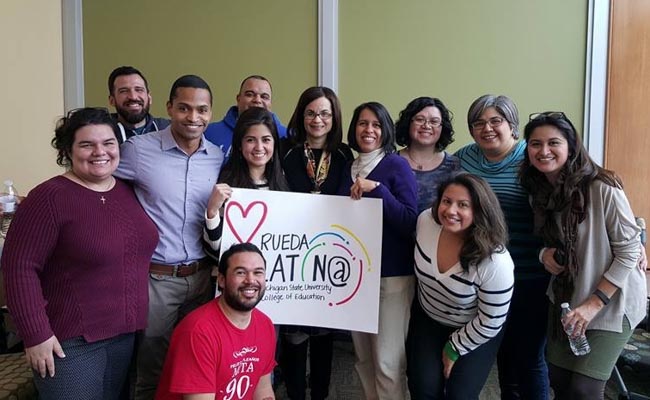
“It felt like a part of our family had achieved a great accomplishment, but also broken down a barrier,” Martinez said.
Crespo was, and still is, a symbol to the Rueda Latin@ community.
“We know that representation matters, and it was a symbolic moment to bring different people together to recognize her achievement within the academy,” Martinez said. “There is a need for more faculty of color, and it’s crucial to recognize the ways a Latina can thrive and achieve in this system. This celebration was a way to show our love and appreciation, a way to return the support and encouragement she had given to us.”
READ MORE
To read more about Crespo’s NSF research project focused on the educational potential of out-of-school activities and educational TV and technology:
Fisch, S.M., Lesh, R., Motoki, E., Crespo, S., & Melfi, V. (2012). Cross-platform learning: Children’s learning from multiple media. Televizion, 25, 42-45.
Crespo, S., Melfi, V., Fisch, S. M., Lesh, R., Motoki, E. (2011). Television, games, and mathematics: Effects of children’s interactions with multiple media. International Journal of Gaming and Computer-Mediated Simulations, 3(3), 1-18.
Fisch, S. M., Lesh, R., Motoki, E., Crespo, S., & Melfi, V. (2011). Children’s mathematical reasoning in online games: Can data mining reveal strategic thinking? Child Development Perspectives, 5(2), 88-92.
To read more about Crespo’s research on Complex Instruction in mathematics education:
Crespo, S. (2020). Complex Instruction in Mathematics Teacher Preparation. In: Peters M. (eds) Encyclopedia of Teacher Education. Springer.
https://doi.org/10.1007/978-981-13-1179-6_239-1
Crespo, S. & Harper, F. (2019). Exploring collaborative mathematics problems with prospective teachers. International Journal of Educational Research. https://doi.org/10.1016/j.ijer.2019.05.003
FOOTNOTES
1. Bannister, N., Kalinec-Craig, C., Bowen, D. & Crespo, S. (2018). Learning to Notice and Name Students’ Mathematical Strengths: A Digital Experience. Journal of Technology and Teacher Education, 26(1), 13-31. Waynesville, NC USA: Society for Information Technology & Teacher Education. Retrieved February 13, 2020 from learntechlib.org/primary/p/181150/
2. Marcy B. Wood, James Sheldon, Mathew D. Felton-Koestler, Joy Oslund, Amy Noelle Parks, Sandra Crespo, & Helen Featherstone. (2019). 8 Teaching Moves Supporting Equitable Participation. Teaching Children Mathematics, 25(4), 218-223. doi:10.5951/teacchilmath.25.4.0218





